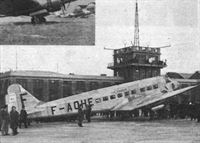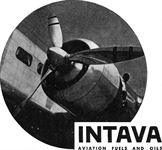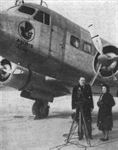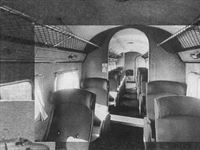
Описание
Страна : Франция
Год : 1936
Транспортный самолет с экипажем из четырех человек
Bloch МВ.220 и МВ.221
Bloch МВ.220 представлял собой цельнометаллический свободнонесущий низкоплан с двумя звездообразными поршневыми двигателями Gnome-Rhone и, по большому счету, являлся французским эквивалентом американских DC-2 и DC-3. Правда, выпущен он был намного меньшей серией.
Проектирование Bloch МВ.220 было выполнено на базе бомбардировщика МВ.210. Основные отличия нового самолета от бомбардировщика заключались в новом фюзеляже и замене двигателей на Gnome-Rhone 14К номинальной мощностью 810 л. с, с трехлопастными воздушными винтами фирмы "Ratier". Первый полет прототипа состоялся в декабре 1935 года, а вскоре последовал заказ на 16 машин. Экипаж включал четыре человека, а в пассажирском салоне могли разместиться 16 человек (по восемь мест на каждый борт, с одним центральным проходом). Дверь в салон располагалась по левому борту.
К середине 1938 года были поставлены 10 самолетов МВ.220, которые использовались только на внутриевропейских маршрутах "Air France". В годы Второй мировой войны большая часть машин была вначале мобилизована ВВС и использовалась в качестве военно-транспортных самолетов, а после поражения Франции эксплуатировались немецкой авиакомпанией "Lufthansa" и авиацией вишистской Франции, а также ВВС Свободной Франции.
По меньшей мере, пять самолетов дожили до окончания войны, были переоборудованы до стандарта МВ.221 - на них установили двигатели Wright R-1820-97 Cyclone, после чего эксплуатировались компанией "Air France". К 1949 году четыре из них были проданы "Societe Auxiliare de Navigation Aerienne" и в течение следующего года были списаны.
ТАКТИКО-ТЕХНИЧЕСКИЕ ХАРАКТЕРИСТИКИ
Bloch МВ.220
Тип: транспортный самолет с экипажем из четырех человек
Силовая установка: два звездообразных ПД Gnome-Rhone 14N-16/17 мощностью по 985 л. с. (734 кВт)
Характеристики: максимальная скорость на оптимальной высоте 330 км/час; крейсерская скорость на оптимальной высоте 280 км/час; практический потолок 7000 м; дальность 1400 км
Масса: пустого 6807 кг; максимальная взлетная 9500 кг
Размеры: размах крыла 22,82 м; длина 19,25 м; площадь крыла 75,00 м;
Вместимость: до 16 пассажиров
Описание:
- Bloch МВ.220 и МВ.221
- Flight, July 1937
AIR FRANCE'S FASTEST
Фотографии
-
Aeroplane Monthly 1986-07 / J.Stroud - Wings of Peace
Регистрационный номер: F-AOHB [7] Bloch 220 F-AOHB Gascogne at le Bourget with the Farman F.224 F-APMC in the background.
Другие самолёты на фотографии: Farman/SNCAC NC.224 - Франция - 1937
-
Jane's All the World Aircraft 1938 / 03 - All the world's aeroplanes
Регистрационный номер: F-AOHB [7] The Bloch 220 Sixteen-passenger Commercial Monoplane (two 915 h.p. Gnome-Rhone 14N engines).
-
Flight 1938-03 / Flight
Регистрационный номер: F-AOHE [2] Views of the Bloch 220 on the ground at Croydon respectively.
-
Flight 1938-03 / Flight
M. Charvet, the Secretary-General of Air France, introduces Mme. Maryse Bastie, the well-known pilot, who christened the Bloch at Le Bourget and afterwards travelled in it over to Croydon for the first regular service on the following day.
-
Flight 1938-04 / Flight Advertisements
The recent introduction of the "Bloch 220" on Air France European Services permits faster times as well as greater comfort. On its first flight this machine smashed the London-Paris record by completing the journey in 51 minutes. Air France offers the European and World traveller a network of regular services which takes him or her to the four corners of the earth or as near there as it is possible to fly.
-
Мировая Авиация 59
Регистрационный номер: F-AOHB [7] Первым регулярным маршрутом для МВ.220 стала линия Париж-Лондон, первый полет выполнен 27 марта 1938 года. Новый самолет позволил сократить продолжительность полета на маршруте до 1 ч 15 мин.
-
Aeroplane Monthly 1990-09 / Personal album. Civil
Регистрационный номер: F-AOHE [2] Air France’s Bloch 220 F-AOHE Aunis, which operated the first Paris - Croydon service of the type, on March 27, 1938, replacing the company's Wibault 283Ts. Powered by two 915 h.p. Gnome-Rhone radial engines, the Bloch 220 first flew in December 1935. Air France took delivery of the first 220s in late 1937. F-AOHE was later converted to a 221 with the installation of Wright Cyclone engines. After the war the aircraft operated with the Societe Auxiliaire de Navigation Aerienne.
-
Aeroplane Monthly 1986-07 / J.Stroud - Wings of Peace
Регистрационный номер: F-AOHB [7] The first production Bloch 220 F-AOHB Gascogne, with original design of flight deck windows.
The rounded rectangular fuselage shape is both structurally interesting and practical from the passengers’ standpoint. -
Aeroplane Monthly 1986-07 / J.Stroud - Wings of Peace
Регистрационный номер: F-AOHJ F-AOHJ Poitou was Bloch 220 No 10. It is seen with de-icer boots.
-
Aeroplane Monthly 1986-07 / J.Stroud - Wings of Peace
Регистрационный номер: F-AOHB [7], F-AOHD Bloch 220 F-AOHB Gascogne (nearest) and F-AOHD Auvergne (second in line), with modified but still sloping windscreens. The third aeroplane has the final production windscreen. At the end of the line are two Potez 62s.
Другие самолёты на фотографии: Potez Potez 62 / 65 - Франция - 1935
-
Aeroplane Monthly 1986-07 / J.Stroud - Wings of Peace
Регистрационный номер: F-AOHC, F-AOHH Bloch 220 F-AOHH Savoie (nearest) with near-vertical windscreen, and next to it F-AOHC Guyenne. The first production aeroplane is the next in line.
-
Aeroplane Monthly 1986-07 / J.Stroud - Wings of Peace
Регистрационный номер: F-AQNL, F-AQNM [3], F-AQNP, D-AKGC [3] Winter line-up at le Bourget. Bloch 220 F-AQNP Lorraine (nearest), F-AQNL Languedoc and, furthest, F-AQNM Provence. The Potez 620 is F-ANQM Martinet.
Другие самолёты на фотографии: Potez Potez 62 / 65 - Франция - 1935
-
Aeroplane Monthly 1987-09 / J.Stroud - Wings of Peace
Регистрационный номер: F-AQNM [3], D-AKGC [3] D.338 F-AQBL Ville d’Orleans at Le Bourget. This example has auxiliary fins mounted on the tailplane. Beyond is the Bloch 220 F-AQNM Provence.
Другие самолёты на фотографии: Dewoitine D.332 / D.333 / D.338 / D.620 - Франция - 1933
-
Aeroplane Monthly 1989-02 / Skywriters
A Lockheed 10 Electra, Bloch 221 and an HP.42 diverted to RAF Kenley during bad weather in 1938.
Другие самолёты на фотографии: Handley Page H.P.42 / H.P.45 - Великобритания - 1930Lockheed Electra 10 - США - 1934
-
Aeroplane Monthly 1979-10 / Croydon /Gone but not forgotten/ (5)
Two RAF Dakotas flank an Air France Bloch 221 in April 1946.
Другие самолёты на фотографии: Douglas DC-3 / C-47 Skytrain/С-53 Skytrooper / Dakota - США - 1935
-
Flight 1939-08 / Flight
IN SERVICE: The first Junkers Ju.90 to be seen in this country arrived on the normal Berlin-London run on August 1. The impressive size of this forty-seater is shown by the relative smallness of the Marcel Bloch on the right. The “accident” on the left is merely a group of Imperial machines, including two Frobisher-class and one Ensign-class liner. The Ju.90’s tail unit is interestingly complicated.
Другие самолёты на фотографии: Armstrong Whitworth Ensign / A.W.27 - Великобритания - 1938De Havilland Albatross / D.H.91 - Великобритания - 1937Junkers Ju.90 - Германия - 1937
-
Aeroplane Monthly 1986-07 / J.Stroud - Wings of Peace
Регистрационный номер: D-AXWA D-AXWA, one of the Bloch 220s which went to Lufthansa. Its original identity has not been traced. It is seen at Aspern Airport, Vienna, in 1940.
-
Flight 1938-03 / Flight
Flight deck of the early Bloch 220, probably the prototype, with three-panel windscreen.
FOR THE PARIS RUN: The control cabin of the new Marcel Bloch 220 which is shortly to be introduced on the London-Paris-Marseilles service by Air France. The radio receiver on the right, matching the blind-flying panel on the left, is an interesting feature and it will be noticed that the windscreen layout is very similar to that of the Wibault which will be replaced. -
Flight 1938-03 / Flight
View aft from the front cabin of a Bloch 220.
-
Aeroplane Monthly 1986-07 / J.Stroud - Wings of Peace
Регистрационный номер: F-AQNM [3], D-AKGC [3] KEITH WOODCOCK'S painting of the Bloch 220 shows F-AQNM which was used by Lufthansa as D-AKGC.
-
Jane's All the World Aircraft 1938 / 03 - All the world's aeroplanes
The Bloch 220 Commercial Monoplane.
- Фотографии
























